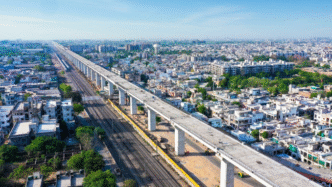The Mumbai–Ahmedabad Bullet Train project is advancing at a rapid speed, with construction of viaducts, bridges, tunnels, and stations. Key milestones, involving river bridges, track laying, OHE installation, and station works, showcases NHSRCL’s continuous efforts toward building India’s most ambitious high-speed rail corridor.
Introduction:
The Mumbai–Ahmedabad High-Speed Rail (MAHSR) corridor, popularly known as the Bullet Train project, is achieving significant milestones, reaffirming India’s progress towards modern and world-class transportation infrastructure. Spanning 508 km, the corridor covers 352 km across Gujarat and Dadra & Nagar Haveli, and 156 km in Maharashtra, linking two major cities with state-of-the-art high-speed connectivity.

Stations and Corridor Design:
The project envisions 12 thematically designed stations across Gujarat and Maharashtra, including Sabarmati, Ahmedabad, Anand, Vadodara, Bharuch, Surat, Bilimora, Vapi, Boisar, Virar, Thane, and Mumbai. Structural work has already been completed for all eight stations in Gujarat, where interior finishing and building works are progressing swiftly. In Maharashtra, foundation and slab works have begun at Mumbai, Virar, and Boisar stations.
Civil Works Progress:
- Viaduct Construction: 317 km
- Pier Works: 396 km
- Pier Foundations: 407 km
- Girder Casting: 337 km
In addition, 17 river bridges across districts such as Valsad, Navsari, Vadodara, Kheda, and Surat have been completed. Eight steel bridges and five pre-stressed concrete (PSC) bridges are also ready.
Noise Barriers and Track Bed:
A critical component of the project is the installation of noise barriers. Approximately 3,90,000 barriers covering 195 km have already been installed across Gujarat. Simultaneously, track bed construction has reached around 198 km, with rail welding underway to form continuous panels of 200 meters, ensuring high-quality high-speed rail tracks.
Electrification and OHE Works:
Electrification works are also progressing steadily. Over 1,600 overhead equipment (OHE) masts have been installed along the Surat–Bilimora section, spanning nearly 40 km of the mainline viaduct. This marks a crucial step towards electrification of the corridor.
Tunnel and Mountain Works:
In Maharashtra, work is ongoing on the 21 km long tunnel between Bandra Kurla Complex (BKC) and Shilphata. Using the advanced New Austrian Tunneling Method (NATM), about 4.5 km of excavation has been achieved from multiple points. Additionally, seven mountain tunnels in Palghar district are under excavation, with 2 km completed out of the planned 6 km.
Future Outlook:
The project is now visibly transforming landscapes across Gujarat and Maharashtra. With structural works nearing completion in Gujarat, interior finishing, track laying, and systems installation are in full swing. In Maharashtra, despite more complex tunneling and urban works, substantial progress has been achieved.
Key Highlights:
- 508 km total corridor length.
- 12 stations across Gujarat and Maharashtra.
- 17 river bridges, 8 steel bridges, and 5 PSC bridges completed.
- 3,90,000 noise barriers installed across 195 km.
- 1,600+ OHE masts erected.
- 198 km track bed completed.
- Structural works done for all Gujarat stations.
Conclusion:
The Bullet Train project is steadily moving towards realization, with impeccable progress in civil works, bridges, stations, and tunnels. Once operational, the corridor will transform travel by significantly reducing travel time, accelerating economic activity, and positioning India on the global high-speed rail map.
Source: NHSRCL – Press Release | Image Credit: NHSRCL
[Nominations are Open] Submit your nomination (free) for the 7th Rail & Metro Awards 2026: Link
![]() Timely insights, straight to your WhatsApp—stay updated with ease!
Timely insights, straight to your WhatsApp—stay updated with ease!
![]() Stay connected to the rail industry—timely news, straight to Telegram!
Stay connected to the rail industry—timely news, straight to Telegram!


